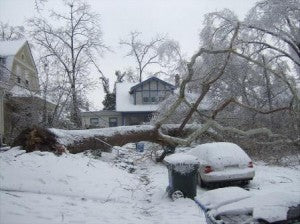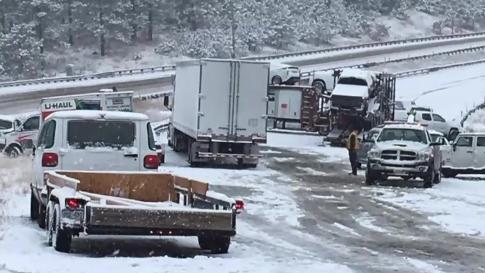The winter weather that Utah experienced was the tail end of a larger storm passing over the Northern Plains. Utah was only under a winter weather advisory, but parts of Minnesota and South Dakota faced a Blizzard warning. On November 18, 2016, however, Winter Storm Argos continued to blow powerful winds and dumped over a foot of snow as it made its way through South Dakota, Nebraska, Iowa, and Minnesota.Snow occasionally accumulating on roads under lake showers. Current image near Stansbury Park. #utwx pic.twitter.com/BBglVkn30u
— NWS Salt Lake City (@NWSSaltLakeCity) November 17, 2016
@NWSTwinCities Snow Drifts approaching 3 ft already @ 9am by morris, MN. Power lines jumping like double dutch. Dangerous Blizzard!! pic.twitter.com/SyjtpDaJkE — Prairie Wind Chasers (@PrairieWndChsrs) November 18, 2016Winter, it would seem, has finally arrived. While the snow may still melt, we can take this as a warning that more winter storms will be coming along. That means it’s high time to get out your winter gear. But what, exactly, should you be prepared with?
- Warmth
 But if there is a power outage, there are still ways to get extra heat, even without a generator.
Portable propane heaters provide reliable heat that that are even safe to use indoors. This image shows off the Mr. Heater Portable Buddy connected to a propane tank. But you don’t necessarily need a tank that large. Instead, smaller one-pound propane cylinders provide up to 6 hours of heat.
Hand and body warmers are a smaller, more space-friendly alternative to larger heaters. Once activated, they produce heat for up to 18 hours. These are ideal for your car’s emergency kit, since they don’t take up much space but can help keep you warm while you wait for assistance should a patch of ice force you off the road. (Of course, keeping blankets, gloves, and hats in your car is also a good idea during the winter months.)
But if there is a power outage, there are still ways to get extra heat, even without a generator.
Portable propane heaters provide reliable heat that that are even safe to use indoors. This image shows off the Mr. Heater Portable Buddy connected to a propane tank. But you don’t necessarily need a tank that large. Instead, smaller one-pound propane cylinders provide up to 6 hours of heat.
Hand and body warmers are a smaller, more space-friendly alternative to larger heaters. Once activated, they produce heat for up to 18 hours. These are ideal for your car’s emergency kit, since they don’t take up much space but can help keep you warm while you wait for assistance should a patch of ice force you off the road. (Of course, keeping blankets, gloves, and hats in your car is also a good idea during the winter months.)
- Shelter
- Food and Water
 Winter storms can dump huge amounts of snow and leave the roads slicker than an ice rink. When this happens, there’s a good chance you could be trapped in your home. We posted an article back in May, 2015 about how one family from Kentucky was trapped inside their home for a couple of days because of a storm that knocked out power and iced the roads. They were stuck indoors, wrapped in blankets, and cooked with a portable propane stove.
Whenever a huge storm of any kind is expected, grocery stores run low on the essentials, including bread, eggs, and milk. But if you have food already stored, you won’t have to rush to the store only to Replace empty shelves. Likewise, having extra water stored can help in a pinch if your water pipes freeze over or water is otherwise unavailable.
Once you have food and water, you will still need an alternate method to cook, just in case. In the example above, the family couldn’t use their stove or oven because it ran on electricity. Fortunately, they had a way to cook. Many people, when the power goes out, will not. Your alternate cooking options range from small gas powered stoves to flameless cookers. Small cookers don’t take up much space, making them ideal for emergencies (and camping and hiking, too!).
Winter storms can dump huge amounts of snow and leave the roads slicker than an ice rink. When this happens, there’s a good chance you could be trapped in your home. We posted an article back in May, 2015 about how one family from Kentucky was trapped inside their home for a couple of days because of a storm that knocked out power and iced the roads. They were stuck indoors, wrapped in blankets, and cooked with a portable propane stove.
Whenever a huge storm of any kind is expected, grocery stores run low on the essentials, including bread, eggs, and milk. But if you have food already stored, you won’t have to rush to the store only to Replace empty shelves. Likewise, having extra water stored can help in a pinch if your water pipes freeze over or water is otherwise unavailable.
Once you have food and water, you will still need an alternate method to cook, just in case. In the example above, the family couldn’t use their stove or oven because it ran on electricity. Fortunately, they had a way to cook. Many people, when the power goes out, will not. Your alternate cooking options range from small gas powered stoves to flameless cookers. Small cookers don’t take up much space, making them ideal for emergencies (and camping and hiking, too!).
- Lighting
 The thing about winter is, it gets dark so early! Many places in the country will need to turn on the lights even at 5:00 in the evening. If the power goes out, you’ll most certainly want some extra light sources. Flashlights are always a good option, but the can become a nuisance if you have to hold on to it for hours on end while you get things done around the house.
One option is a flashlight that charges in a base that plugs into a wall outlet. As soon as the power goes out, the base lights up, not only illumining the room, but also helping you Replace your flashlight so you can reach the rest of your prep in other darkened rooms. Lanterns are also a good option, since they provide light while standing or hanging on their own.
Of course, books and board games are also necessary when you’re trapped at home, and anything else you and your family would enjoy (like snacks and blanket forts). But before the next storm comes, make sure you’re prepared with these basic necessities to see you though cold days and even colder nights.
The thing about winter is, it gets dark so early! Many places in the country will need to turn on the lights even at 5:00 in the evening. If the power goes out, you’ll most certainly want some extra light sources. Flashlights are always a good option, but the can become a nuisance if you have to hold on to it for hours on end while you get things done around the house.
One option is a flashlight that charges in a base that plugs into a wall outlet. As soon as the power goes out, the base lights up, not only illumining the room, but also helping you Replace your flashlight so you can reach the rest of your prep in other darkened rooms. Lanterns are also a good option, since they provide light while standing or hanging on their own.
Of course, books and board games are also necessary when you’re trapped at home, and anything else you and your family would enjoy (like snacks and blanket forts). But before the next storm comes, make sure you’re prepared with these basic necessities to see you though cold days and even colder nights.
 Freeze-Dried Vegetable Chef Combo Giveaway
Freeze-Dried Vegetable Chef Combo Giveaway


3 comments
Joe C.
You have stated that “Portable propane heaters provide reliable heat that are even safe to use indoors.” I have heard and read just the opposite. Can you please elaborate? Thank you.
Lois Grossman
When looking for a wood burning stove for heat, do yourself a favor and forget ornate type. Look for large, flat tops to use for back up cooking in power outages. Keeps your home warm and your tummy full of yummy warm food. One year we had a lulu of a storm, 18 days without power and I had 3 families from my neighborhood living with me. Talk about camping out. What a hoot ! The garage was the refrigerator and the patio was the freezer. We all survived and even remained friends after.
Emergency Essentials
Hi Joe,
This answer comes directly from the manufacturer’s web site:
“There are a couple of required safety features needed for ventfree heaters to be used indoors safely. A BURNER that is 99.9% efficient at burning all the gas is consumes so that very little CO or carbon monoxide is emitted. The heater also requires a ODS or Oxygen Depletion System that will shut off the heater if the Oxygen level drops to a still safe 18%. Because these heaters are portable, they also require a TIP SWITCH so if it they are knocked over the gas flow stops shutting off the flame and gas. Last there is a FLAME SENSOR safety shut-off system that will shut off all gas flow if the flame goes out.”
I hope that helps clear things up.